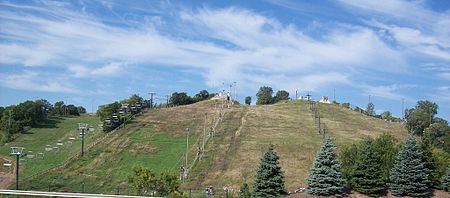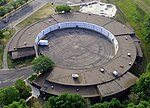Buck Hill

Buck Hill is a ski hill in Burnsville, Minnesota, a suburb south of Minneapolis. It is one of three ski areas in the Twin Cities metropolitan area; the others are Afton Alps and Hyland Ski and Snowboard Area. Buck Hill opened in 1954 and offers ski, snowboard, and tubing trails. Artificial snow is often used to maintain the slopes, because while Minnesota's winters are cold, the average annual snowfall is low for a ski area: less than 60 in (150 cm).Buck Hill faces east, overlooking Interstate 35. It is owned by David and Corrine "Chip" Solner. The ski area is lighted for night skiing, and operates three chairlifts (2 quads, 1 triple) and multiple surface tows (trail map). The base area consists of a parking lot and a short strip of lodges. The ski runs use the east face of the hill, with the other sides occupied by residential housing, and a municipal water tower sharing the summit. The ski area's vertical drop is 310 feet (94 m).
Excerpt from the Wikipedia article Buck Hill (License: CC BY-SA 3.0, Authors, Images).Buck Hill
Buck Hill Road,
Geographical coordinates (GPS) Address Nearby Places Show on map
Geographical coordinates (GPS)
| Latitude | Longitude |
|---|---|
| N 44.724 ° | E -93.283 ° |
Address
Buck Hill Road
55337
Minnesota, United States
Open on Google Maps





